2006 LAND ROVER FRELANDER 2 air condition
[x] Cancel search: air conditionPage 10 of 3229
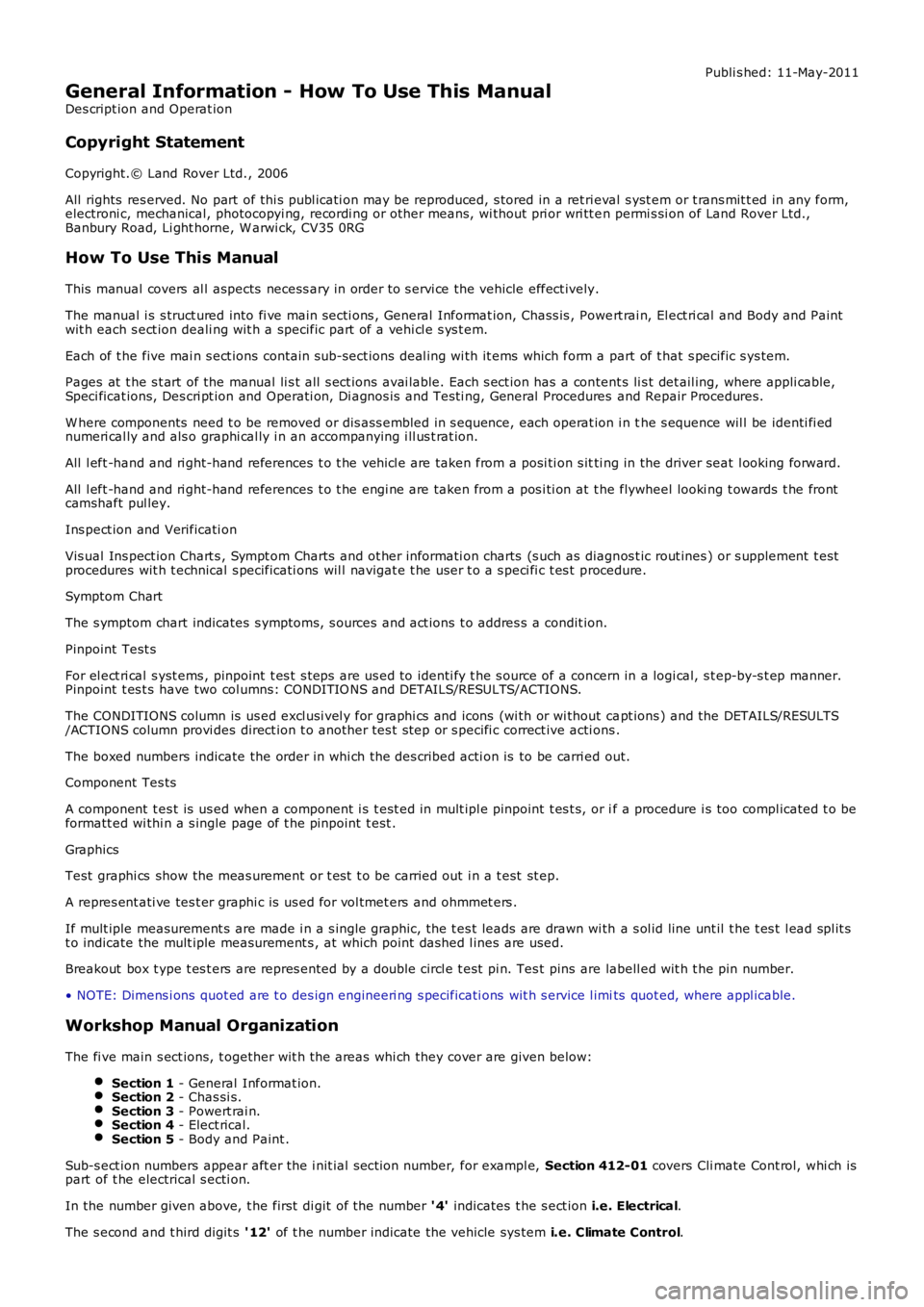
Publi s hed: 11-May-2011
General Information - How To Use This Manual
Des cript ion and Operat ion
Copyright Statement
Copyright.© Land Rover Ltd., 2006
All rights res erved. No part of thi s publ icati on may be reproduced, s tored in a ret ri eval s yst em or t rans mit t ed in any form,electroni c, mechanical, photocopyi ng, recordi ng or other means, wi thout pri or wri tt en permi s si on of Land Rover Ltd.,Banbury Road, Li ght horne, W arwi ck, CV35 0RG
How To Use This Manual
This manual covers al l aspects necess ary in order to s ervi ce the vehicle effect ively.
The manual i s s truct ured into fi ve main secti ons , General Informat ion, Chass is , Powert rai n, El ect ri cal and Body and Paintwit h each s ect ion deali ng wit h a specific part of a vehi cl e s ys t em.
Each of t he five mai n s ect ions contain sub-sect ions deal ing wi th it ems which form a part of t hat s pecific s ys tem.
Pages at t he s t art of the manual li s t all s ect ions avai lable. Each s ect ion has a content s li s t det ail ing, where appli cable,Speci ficat ions, Des cri pt ion and Operati on, Di agnos is and Tes ti ng, General Procedures and Repair Procedures.
W here components need t o be removed or dis ass embled in s equence, each operat ion i n the s equence wil l be identi fi ednumeri cal ly and als o graphi cal ly i n an accompanying i ll us t rat ion.
All l eft -hand and ri ght-hand references t o t he vehi cl e are taken from a posi ti on s itti ng in the driver seat l ooking forward.
All l eft -hand and ri ght-hand references t o t he engi ne are taken from a pos i ti on at the flywheel looki ng t owards t he frontcamshaft pul ley.
Ins pect ion and Verificati on
Vis ual Ins pect ion Chart s , Sympt om Charts and ot her informati on charts (s uch as diagnos t ic rout ines ) or s upplement t estprocedures wit h t echnical s pecificati ons wil l navigat e t he user t o a s peci fi c t es t procedure.
Symptom Chart
The s ymptom chart indicates s ymptoms, s ources and act ions t o addres s a condit ion.
Pinpoint Test s
For el ect ri cal s yst ems , pinpoint t es t s t eps are us ed to identi fy t he s ource of a concern in a logi cal, s t ep-by-s t ep manner.Pinpoint t es t s have two col umns: CONDITIO NS and DETAILS/RESULTS/ACTIONS.
The CONDITIONS column is us ed excl usi vel y for graphi cs and icons (wi th or wi thout capt ions ) and the DETAILS/RESULTS/ACTIONS column provi des direct ion t o another tes t s tep or s pecifi c correct ive acti ons .
The boxed numbers indicate the order in whi ch the des cribed acti on is to be carri ed out.
Component Tes ts
A component t es t is us ed when a component i s t est ed in mult ipl e pinpoint t es t s, or if a procedure i s too compl icated t o beformatt ed wi thi n a s ingle page of t he pinpoint t est .
Graphics
Test graphi cs show the meas urement or t es t t o be carried out i n a t est st ep.
A repres ent ati ve tes t er graphi c is us ed for vol tmet ers and ohmmet ers .
If mult iple measurement s are made i n a s ingle graphic, the t es t leads are drawn wi th a s ol id line unt il t he t es t l ead spl it st o indicate the mult iple measurement s , at which point dashed l ines are used.
Breakout box t ype t es t ers are repres ented by a doubl e circl e t est pi n. Tes t pins are labell ed wit h t he pin number.
• NOTE: Dimens i ons quot ed are t o des ign engineeri ng s pecificati ons wit h s ervice l imits quot ed, where appl icable.
Workshop Manual Organization
The fi ve main s ect ions, t ogether wit h t he areas whi ch they cover are given below:
Section 1 - General Informat ion.Section 2 - Chas si s.Section 3 - Powert rai n.Section 4 - Elect rical.Section 5 - Body and Paint .
Sub-s ect ion numbers appear aft er the i nit ial s ect ion number, for exampl e, Section 412-01 covers Cli mate Cont rol, whi ch ispart of t he electrical s ecti on.
In the number given above, t he first di git of the number ' 4' indicates t he s ect ion i.e. Electrical.
The s econd and t hird digit s ' 12' of t he number indicate the vehicle sys tem i.e. Climate Control.
Page 11 of 3229
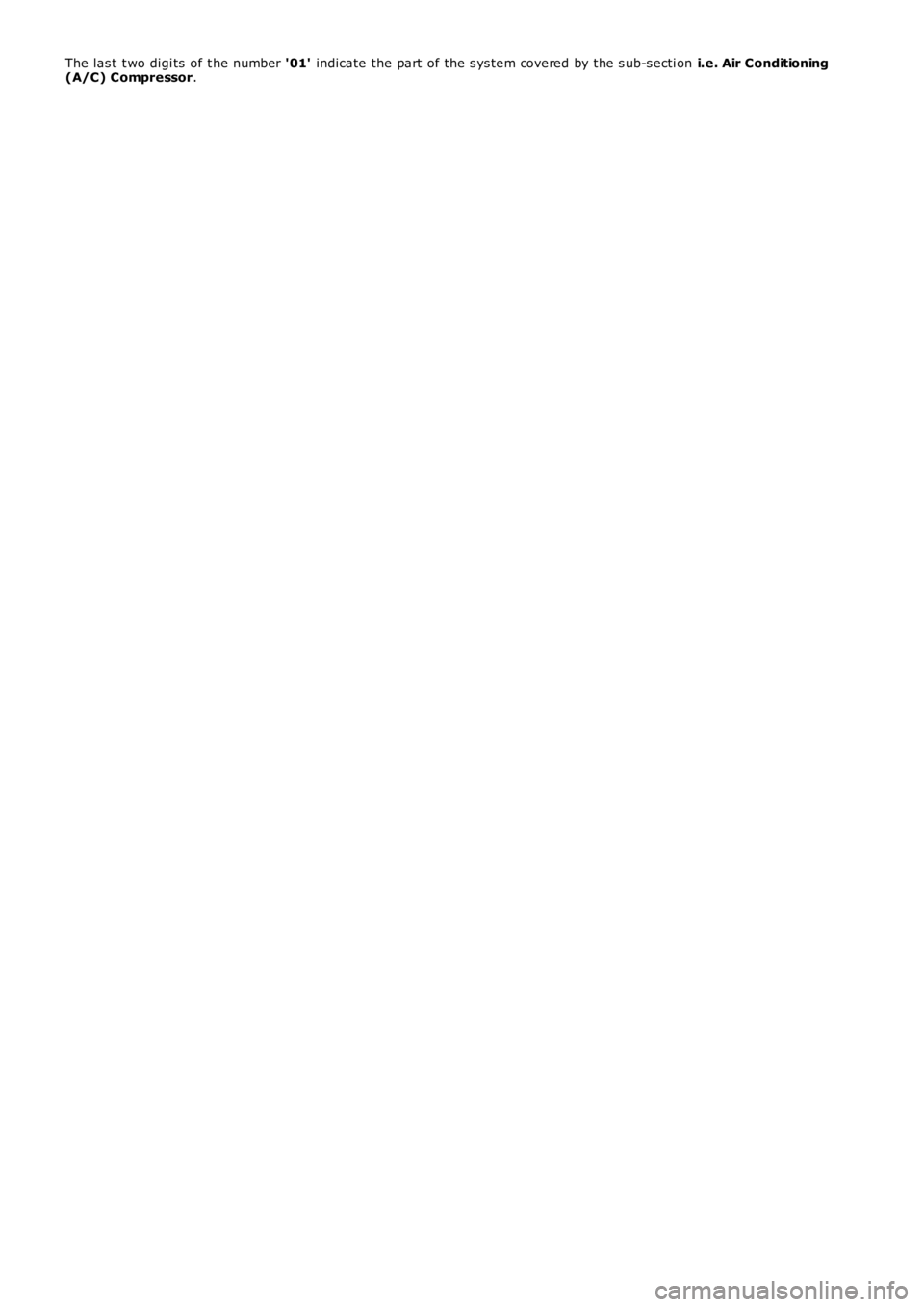
The las t t wo digi ts of t he number '01' indicate the part of the s ys tem covered by the s ub-s ecti on i.e. Air Conditioning(A/C) Compressor.
Page 29 of 3229
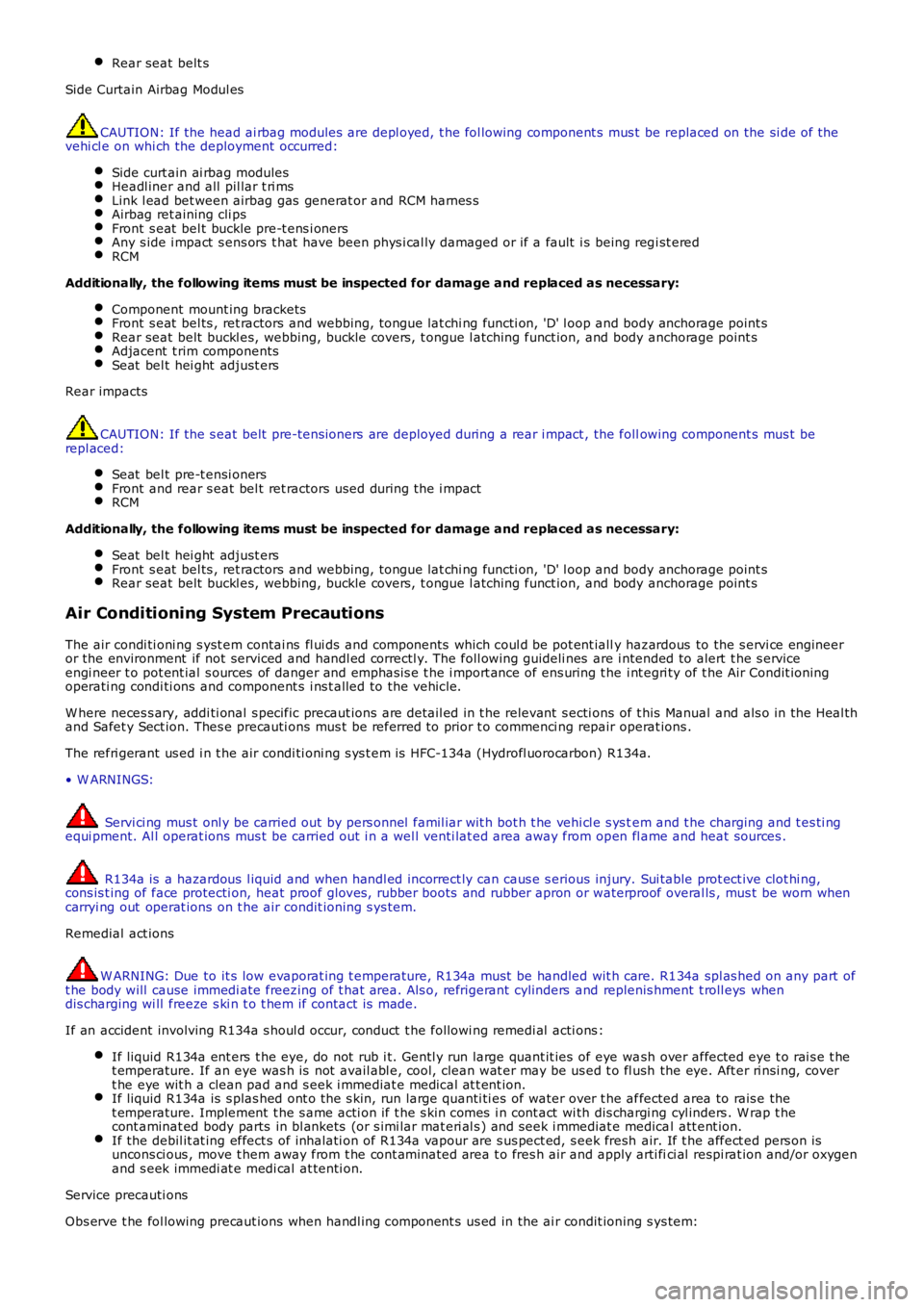
Rear seat belt s
Side Curtain Airbag Modul es
CAUTION: If the head ai rbag modules are depl oyed, t he fol lowing component s mus t be replaced on the si de of thevehi cl e on whi ch the deployment occurred:
Side curt ain ai rbag modulesHeadl iner and all pil lar t ri msLink l ead bet ween airbag gas generat or and RCM harnes sAirbag ret aining cli psFront s eat bel t buckle pre-t ens i onersAny s ide i mpact s ens ors t hat have been phys i cal ly damaged or if a fault i s being regi st eredRCM
Additionally, the following items must be inspected for damage and replaced as necessary:
Component mount ing bracketsFront s eat bel ts , ret ractors and webbing, tongue lat chi ng functi on, 'D' l oop and body anchorage point sRear seat belt buckl es, webbing, buckle covers , t ongue l atching funct ion, and body anchorage point sAdjacent t rim componentsSeat bel t hei ght adjust ers
Rear impacts
CAUTION: If the s eat belt pre-tens ioners are deployed during a rear i mpact , the following component s mus t berepl aced:
Seat bel t pre-t ensi onersFront and rear s eat bel t ret ractors used during t he i mpactRCM
Additionally, the following items must be inspected for damage and replaced as necessary:
Seat bel t hei ght adjust ersFront s eat bel ts , ret ractors and webbing, tongue lat chi ng functi on, 'D' l oop and body anchorage point sRear seat belt buckl es, webbing, buckle covers , t ongue l atching funct ion, and body anchorage point s
Air Conditioning System Precautions
The air condi ti oni ng s yst em contai ns fl ui ds and components which coul d be pot ent ially hazardous to the s ervi ce engineeror the environment if not serviced and handl ed correctl y. The foll owing guideli nes are i ntended to alert t he s erviceengi neer t o pot ent ial s ources of danger and emphas is e t he i mport ance of ens uring t he i nt egri ty of t he Air Condit ioningoperati ng condi ti ons and component s i ns t alled to the vehicle.
W here neces s ary, addi ti onal s pecific precaut ions are det ail ed in t he relevant s ecti ons of t his Manual and als o in the Heal thand Safet y Sect ion. Thes e precauti ons mus t be referred to prior t o commenci ng repair operat ions .
The refri gerant us ed i n t he air condi ti oni ng s ys t em i s HFC-134a (Hydrofl uorocarbon) R134a.
• W ARNINGS:
Servi ci ng mus t onl y be carried out by pers onnel famil iar wit h bot h t he vehi cl e s ys tem and t he charging and t es ti ngequi pment. Al l operat ions mus t be carried out i n a wel l venti lat ed area away from open fl ame and heat sources .
R134a is a hazardous l iquid and when handl ed incorrect ly can caus e s erious injury. Sui table prot ect ive clot hi ng,cons is t ing of face protecti on, heat proof gloves, rubber boots and rubber apron or waterproof overal ls , mus t be worn whencarryi ng out operat ions on t he air condit ioning s ys tem.
Remedial act ions
W ARNING: Due to it s low evaporat ing t emperat ure, R134a must be handled wit h care. R134a spl as hed on any part oft he body will cause immedi ate freezing of t hat area. Als o, refrigerant cylinders and replenis hment t roll eys whendis charging wi ll freeze s ki n t o t hem if contact is made.
If an accident involving R134a s houl d occur, conduct t he followi ng remedi al acti ons :
If liquid R134a ent ers t he eye, do not rub i t. Gentl y run large quant it ies of eye wash over affected eye t o rai s e t het emperature. If an eye was h is not avail abl e, cool, clean wat er may be us ed t o fl ush the eye. Aft er ri nsi ng, covert he eye wit h a clean pad and s eek i mmediat e medical at t ent ion.If liquid R134a is s plas hed ont o t he s kin, run large quanti ti es of water over t he affected area to rais e thet emperature. Implement t he s ame acti on if t he s kin comes i n cont act wi th dis chargi ng cyl inders . W rap t hecont aminat ed body parts in bl ankets (or s imi lar mat eri al s ) and seek i mmediat e medical att ent ion.If the debil it at ing effect s of inhalati on of R134a vapour are s us pect ed, s eek fresh air. If t he affect ed pers on isuncons ci ous , move t hem away from t he cont aminated area t o fres h air and apply arti fici al respi rat ion and/or oxygenand s eek immedi at e medi cal at tenti on.
Service precauti ons
Obs erve t he fol lowing precaut ions when handl ing component s us ed in the ai r condit ioning s ys tem:
Page 34 of 3229
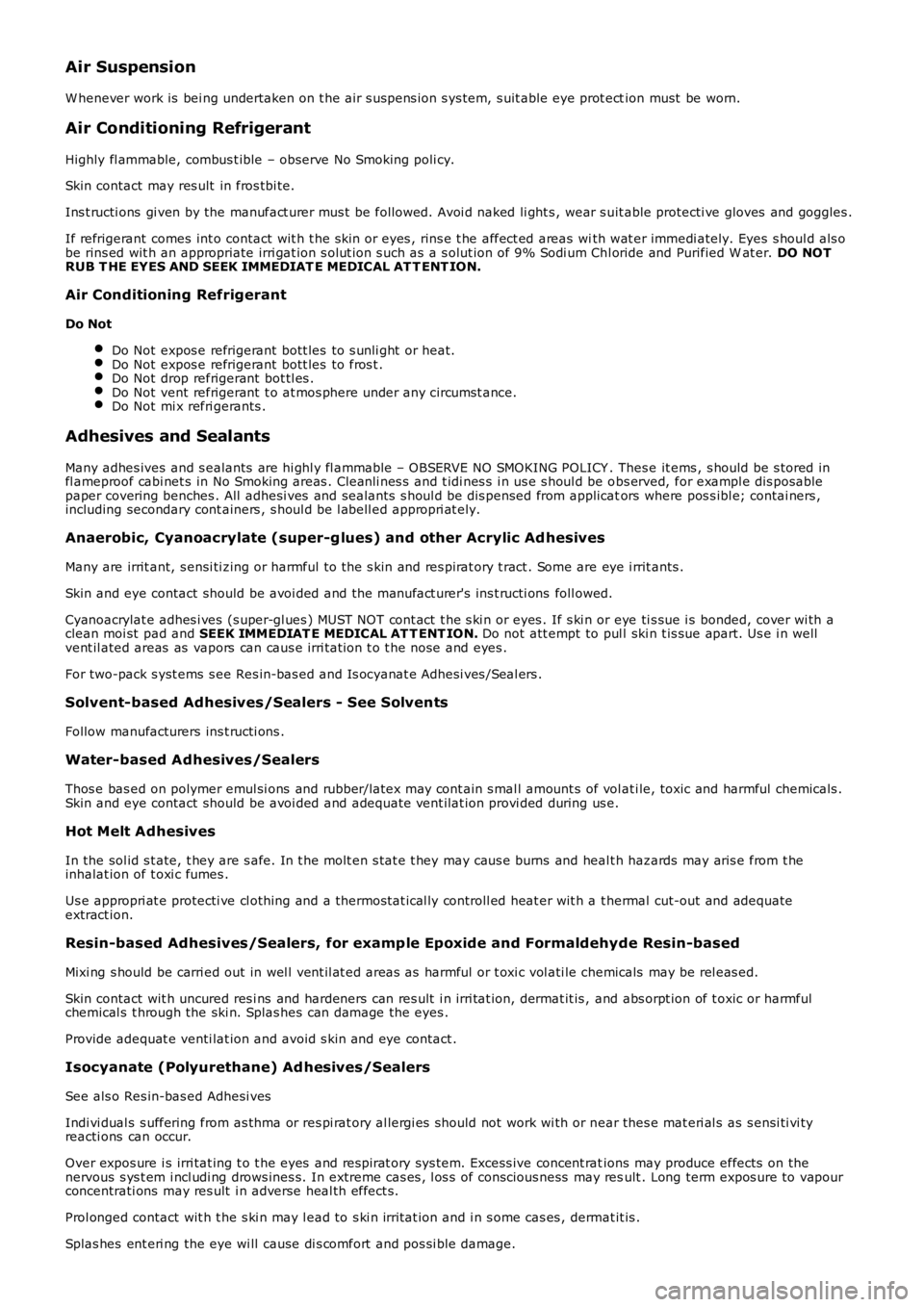
Air Suspension
W henever work is bei ng undertaken on t he air s us pens ion s ys tem, s uit able eye prot ection must be worn.
Air Conditioning Refrigerant
Highly fl ammable, combus t ible – observe No Smoking poli cy.
Skin contact may res ult in fros tbi te.
Ins t ructi ons gi ven by the manufact urer mus t be followed. Avoi d naked li ght s , wear s uit able protecti ve gloves and goggles .
If refrigerant comes int o contact wit h t he s ki n or eyes , rins e t he affect ed areas with wat er immedi ately. Eyes s houl d als obe rins ed wit h an appropriate irri gat ion s olut ion s uch as a s olut ion of 9% Sodi um Chl oride and Purified W at er. DO NOTRUB T HE EYES AND SEEK IMMEDIAT E MEDICAL AT T ENT ION.
Air Conditioning Refrigerant
Do Not
Do Not expos e refrigerant bott les to s unli ght or heat.Do Not expos e refrigerant bott les to fros t .Do Not drop refrigerant bot tl es .Do Not vent refrigerant t o at mos phere under any circums t ance.Do Not mi x refri gerants .
Adhesives and Sealants
Many adhes ives and s ealants are hi ghl y fl ammable – OBSERVE NO SMOKING POLICY . Thes e it ems , s hould be s tored infl ameproof cabi net s in No Smoking areas . Cleanli nes s and t idi nes s i n us e s houl d be obs erved, for exampl e dis posablepaper covering benches . All adhesi ves and sealant s s houl d be dis pensed from applicators where pos s ibl e; contai ners ,including secondary cont ainers , s houl d be l abell ed appropri at ely.
Anaerobic, Cyanoacrylate (super-g lues) and other Acrylic Ad hesives
Many are irrit ant, s ensi ti zing or harmful to the s kin and res pirat ory t ract . Some are eye i rrit ants .
Skin and eye contact should be avoi ded and the manufact urer's ins t ructi ons foll owed.
Cyanoacrylat e adhes i ves (s uper-gl ues ) MUST NOT cont act t he s ki n or eyes . If s ki n or eye ti s sue i s bonded, cover wi th aclean moi st pad and SEEK IMMEDIAT E MEDICAL AT T ENT ION. Do not att empt to pul l ski n t is sue apart. Us e i n wellvent il ated areas as vapors can caus e irri tat ion t o t he nose and eyes .
For two-pack s yst ems s ee Res in-bas ed and Is ocyanat e Adhesi ves /Seal ers .
Solvent-based Adhesives/Sealers - See Solvents
Follow manufacturers ins t ructi ons .
Water-based Adhesives/Sealers
Thos e bas ed on polymer emul si ons and rubber/latex may cont ain s mal l amount s of vol ati le, toxic and harmful chemicals .Skin and eye contact should be avoi ded and adequate vent ilat ion provi ded during us e.
Hot Melt Adhesives
In the sol id s t ate, t hey are s afe. In t he molt en s tat e t hey may caus e burns and healt h hazards may aris e from t heinhalat ion of t oxi c fumes .
Us e appropri at e protecti ve cl othing and a t hermos tat ical ly controll ed heat er wit h a t hermal cut-out and adequateextract ion.
Resin-based Adhesives/Sealers, for examp le Epoxide and Formaldehyde Resin-based
Mixi ng s hould be carri ed out in wel l vent il at ed areas as harmful or t oxi c vol ati le chemicals may be rel eas ed.
Skin contact wit h uncured res i ns and hardeners can res ult i n irri tat ion, dermat it is , and abs orpt ion of t oxic or harmfulchemical s t hrough the ski n. Splas hes can damage the eyes .
Provide adequat e venti lat ion and avoid s kin and eye contact .
Isocyanate (Polyurethane) Ad hesives/Sealers
See als o Res in-bas ed Adhesi ves
Indi vi dual s s uffering from as thma or res pi rat ory al lergi es should not work wi th or near thes e mat eri al s as s ensi ti vi tyreacti ons can occur.
Over expos ure i s irri tat ing t o t he eyes and res pirat ory sys tem. Excess ive concent rations may produce effects on thenervous s ys t em i ncl udi ng drows ines s. In extreme cas es , l os s of conscious ness may result . Long term expos ure to vapourconcentrati ons may res ult i n adverse heal th effect s.
Prol onged contact wit h t he s ki n may l ead to s ki n irri tat ion and i n s ome cas es , dermat it is .
Splas hes ent eri ng the eye wi ll cause di s comfort and pos si ble damage.
Page 104 of 3229
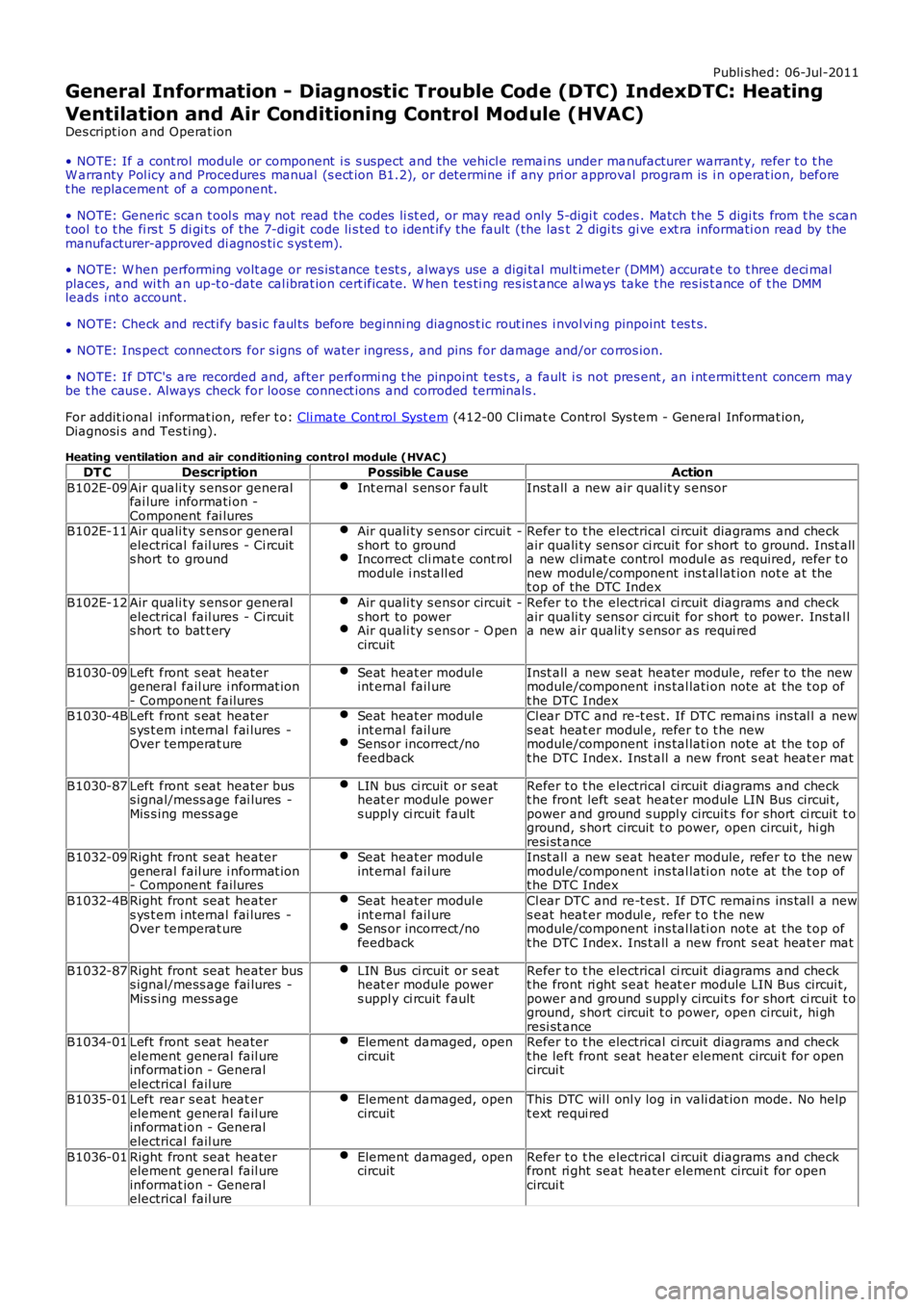
Publi shed: 06-Jul-2011
General Information - Diagnostic Trouble Code (DTC) IndexDTC: Heating
Ventilation and Air Conditioning Control Module (HVAC)
Des cript ion and Operat ion
• NOTE: If a cont rol module or component i s s uspect and the vehicl e remai ns under manufacturer warrant y, refer t o t heW arranty Pol icy and Procedures manual (s ect ion B1.2), or determine i f any pri or approval program is i n operat ion, beforet he replacement of a component.
• NOTE: Generic scan t ool s may not read the codes li st ed, or may read only 5-digi t codes . Match t he 5 digi ts from t he s cant ool t o t he fi rs t 5 di gi ts of the 7-digit code li s ted t o i dent ify the fault (the last 2 digi ts gi ve ext ra informati on read by themanufacturer-approved di agnos ti c s ys t em).
• NOTE: W hen performing volt age or res is t ance t est s , always use a digi tal mult imeter (DMM) accurat e t o t hree deci malplaces, and wi th an up-t o-date cal ibrat ion cert ificate. W hen tes ti ng res is t ance al ways take t he res is t ance of t he DMMleads i nt o account .
• NOTE: Check and recti fy bas ic faul ts before beginni ng diagnos t ic rout ines i nvol vi ng pinpoint t es t s.
• NOTE: Ins pect connect ors for s igns of water ingres s , and pins for damage and/or corros ion.
• NOTE: If DTC's are recorded and, after performi ng t he pinpoint tes t s, a fault i s not pres ent , an i nt ermit tent concern maybe t he caus e. Always check for loose connect ions and corroded terminals .
For addit ional informat ion, refer t o: Cli mate Cont rol Syst em (412-00 Cl imat e Control Sys tem - General Informat ion,Diagnosi s and Tes ti ng).
Heating ventilation and air conditioning control module (HVAC )
DT CDescriptionPossible CauseAction
B102E-09Air quali ty s ens or generalfai lure informati on -Component fai lures
Int ernal s ens or faultInst all a new air qual it y s ensor
B102E-11Air quali ty s ens or generalelectrical fail ures - Ci rcuits hort to ground
Air quali ty s ens or circui t -s hort to groundIncorrect cli mat e cont rolmodule i nst all ed
Refer t o t he electrical ci rcuit diagrams and checkair quali ty sens or ci rcuit for short to ground. Inst alla new cl imat e control modul e as required, refer t onew modul e/component ins t al lat ion not e at thet op of the DTC Index
B102E-12Air quali ty s ens or generalelectrical fail ures - Ci rcuits hort to bat t ery
Air quali ty s ens or circui t -s hort to powerAir quali ty s ens or - O pencircuit
Refer t o t he electrical ci rcuit diagrams and checkair quali ty sens or ci rcuit for short to power. Ins tal la new air qualit y s ensor as requi red
B1030-09Left front s eat heatergeneral fail ure i nformat ion- Component failures
Seat heat er modul eint ernal fail ureInst all a new seat heater module, refer to the newmodule/component ins tal lati on note at the t op oft he DTC IndexB1030-4BLeft front s eat heaters ys t em i nternal fai lures -Over temperat ure
Seat heat er modul eint ernal fail ureSens or incorrect /nofeedback
Cl ear DTC and re-t es t. If DTC remai ns ins tal l a news eat heat er modul e, refer t o t he newmodule/component ins tal lati on note at the t op oft he DTC Index. Ins t all a new front s eat heat er mat
B1030-87Left front s eat heater buss ignal/mess age fai lures -Mis s ing mess age
LIN bus ci rcuit or s eatheat er module powers uppl y ci rcuit fault
Refer t o t he electrical ci rcuit diagrams and checkt he front left seat heater module LIN Bus circui t,power and ground s uppl y circuit s for short ci rcuit t oground, s hort circuit t o power, open circui t, hi ghresi st anceB1032-09Right front seat heatergeneral fail ure i nformat ion- Component failures
Seat heat er modul eint ernal fail ureInst all a new seat heater module, refer to the newmodule/component ins tal lati on note at the t op oft he DTC Index
B1032-4BRight front seat heaters ys t em i nternal fai lures -Over temperat ure
Seat heat er modul eint ernal fail ureSens or incorrect /nofeedback
Cl ear DTC and re-t es t. If DTC remai ns ins tal l a news eat heat er modul e, refer t o t he newmodule/component ins tal lati on note at the t op oft he DTC Index. Ins t all a new front s eat heat er mat
B1032-87Right front seat heater buss ignal/mess age fai lures -Mis s ing mess age
LIN Bus ci rcuit or s eatheat er module powers uppl y ci rcuit fault
Refer t o t he electrical ci rcuit diagrams and checkt he front ri ght s eat heat er module LIN Bus circui t,power and ground s uppl y circuit s for short ci rcuit t oground, s hort circuit t o power, open circui t, hi ghresi st anceB1034-01Left front s eat heaterelement general fail ureinformat ion - Generalelectrical fail ure
Element damaged, opencircuitRefer t o t he electrical ci rcuit diagrams and checkt he left front seat heater element circui t for opencircui t
B1035-01Left rear s eat heat erelement general fail ureinformat ion - Generalelectrical fail ure
Element damaged, opencircuitThis DTC wil l onl y log in vali dat ion mode. No hel pt ext requi red
B1036-01Right front seat heaterelement general fail ureinformat ion - Generalelectrical fail ure
Element damaged, opencircuitRefer t o t he electrical ci rcuit diagrams and checkfront ri ght seat heater element circui t for opencircui t
Page 181 of 3229
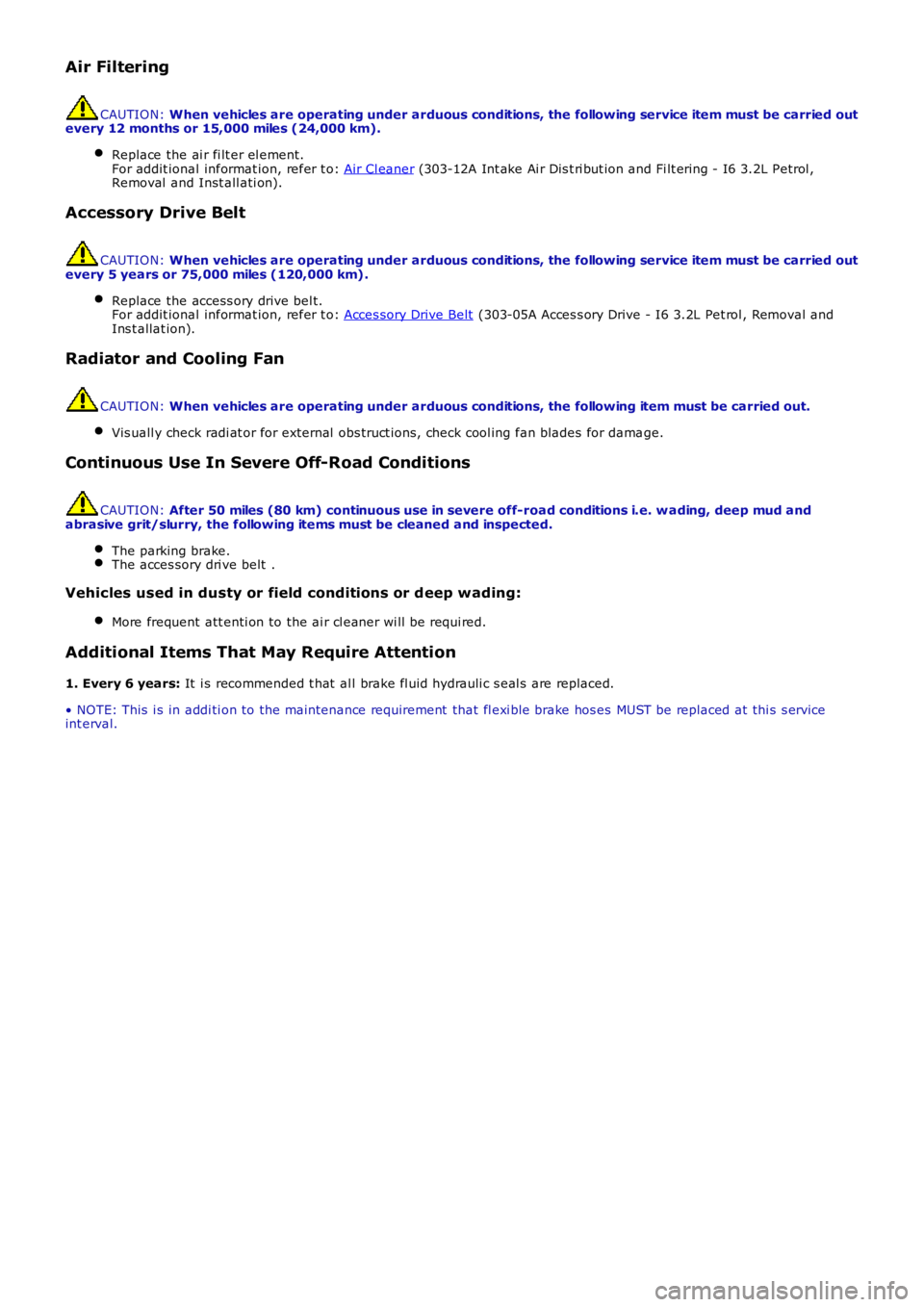
Air Filtering
CAUTION: When vehicles are operating under arduous conditions, the following service item must be carried outevery 12 months or 15,000 miles (24,000 km).
Replace the ai r fi lt er el ement.For addit ional informat ion, refer t o: Air Cl eaner (303-12A Int ake Ai r Dis t ri but ion and Fi lt ering - I6 3.2L Petrol ,Removal and Inst all ati on).
Accessory Drive Belt
CAUTION: When vehicles are operating under arduous conditions, the following service item must be carried outevery 5 years or 75,000 miles (120,000 km).
Replace the access ory drive bel t.For addit ional informat ion, refer t o: Acces sory Drive Belt (303-05A Acces s ory Drive - I6 3.2L Pet rol , Removal andIns t allat ion).
Radiator and Cooling Fan
CAUTION: When vehicles are operating under arduous conditions, the following item must be carried out.
Vis uall y check radi at or for external obs truct ions , check cool ing fan blades for damage.
Continuous Use In Severe Off-Road Conditions
CAUTION: After 50 miles (80 km) continuous use in severe off-road conditions i.e. w ading, deep mud andabrasive grit/slurry, the following items must be cleaned and inspected.
The parking brake.The acces sory dri ve belt .
Vehicles used in dusty or field conditions or d eep wading:
More frequent att enti on to the ai r cl eaner wi ll be requi red.
Additional Items That May Require Attention
1. Every 6 years: It i s recommended t hat al l brake fl uid hydrauli c s eal s are replaced.
• NOTE: This i s in addi ti on to the maintenance requirement that fl exi ble brake hos es MUST be replaced at thi s s erviceint erval.
Page 192 of 3229
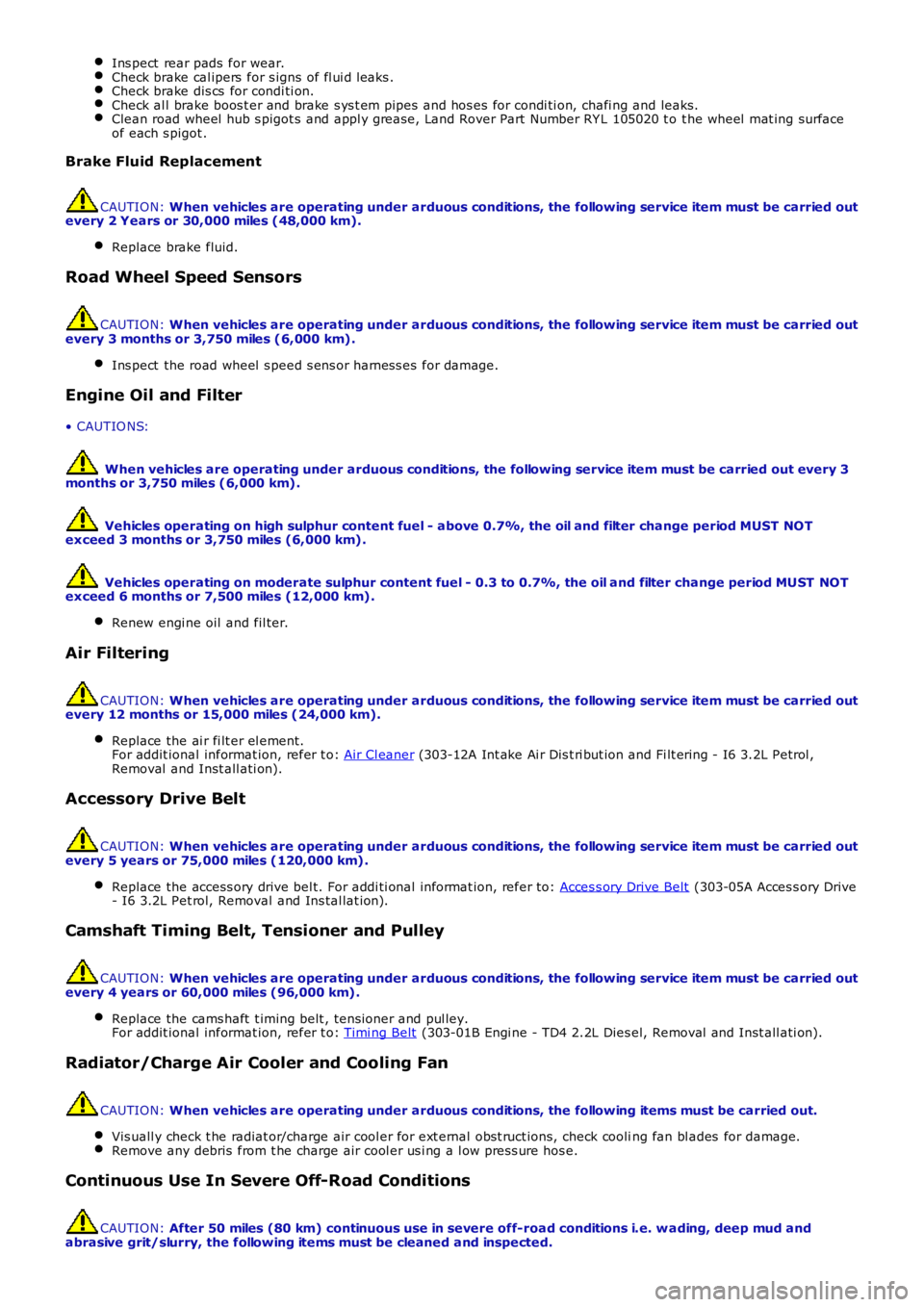
Ins pect rear pads for wear.
Check brake cal ipers for s igns of fl ui d l eaks .
Check brake dis cs for condi ti on.
Check al l brake boos t er and brake s ys t em pipes and hos es for condi ti on, chafi ng and
leaks.Clean road wheel hub s pigot s and appl y greas e, Land Rover Part Number RY L 105020 t o
t he wheel mat ing surface
of each s pigot . Brake Fluid Replacement
CAUTION:
When vehicles are operating under arduous conditions, the following service item mus t be carried out
every 2 Years or 30,000 miles (48,000 km).
Replace brake fluid. Road Wheel Speed Sensors
CAUTION:
When vehicles are operating under arduous conditions, the following service item mus t be carried out
every 3 months or 3,750 miles (6,000 km).
Ins pect the road wheel s peed s ens or harness es for damage. Engine Oil and Filter
• CAUTIO NS:
When vehicles are operating under arduous conditions, the following service item mus t be carried out every 3
months or 3,750 miles (6,000 km).
Vehicles operating on high sulphur content fuel - above 0.7%, the oil and filter cha nge period MUST NOT
exceed 3 months or 3,750 miles (6,000 km).
Vehicles operating on moderate sulphur content fuel - 0.3 to 0.7%, the oil and filte r change period MUST NOT
exceed 6 months or 7,500 miles (12,000 km).
Renew engi ne oil and fil ter. Air Filtering
CAUTION:
When vehicles are operating under arduous conditions, the following service item mus t be carried out
every 12 months or 15,000 miles (24,000 km).
Replace the ai r fi lt er el ement.
For addit ional informat ion, refer t o: Air Cl eaner (303-12A Int ake Ai r Dis t ri but ion and Fi lt ering - I6 3.2L Petrol ,
Removal and Inst all ati on). Accessory Drive Belt
CAUTION:
When vehicles are operating under arduous conditions, the following service item mus t be carried out
every 5 years or 75,000 miles (120,000 km).
Replace the access ory drive bel t. For addi ti onal informat ion, refer to: Acces s ory Drive Belt (303-05A Acces s ory Drive
- I6 3.2L Pet rol, Removal and Ins tal lat ion). Camshaft Timing Belt, Tensioner and Pulley
CAUTION:
When vehicles are operating under arduous conditions, the following service item mus t be carried out
every 4 years or 60,000 miles (96,000 km).
Replace the cams haft t iming belt , tens ioner and pul ley.
For addit ional informat ion, refer t o: Timi ng Belt (303-01B Engi ne - TD4 2.2L Dies el, Removal and Inst all ati on).
Radiator/Charge Air Cooler and Cooling Fan
CAUTION:
When vehicles are operating under arduous conditions, the following items must be ca rried out.
Vis uall y check t he radiat or/charge air cool er for ext ernal obst ruct ions, check cooli ng fan bl ades for damage.Remove any debris from t he charge air cool er us i ng a l ow pres s ure hos e.
Continuous Use In Severe Off-Road Conditions
CAUTION:
After 50 miles (80 km) continuous use in severe off-road conditions i.e. w ading, dee p mud and
abrasive grit/slurry, the following items must be cleaned and inspected.
Page 300 of 3229
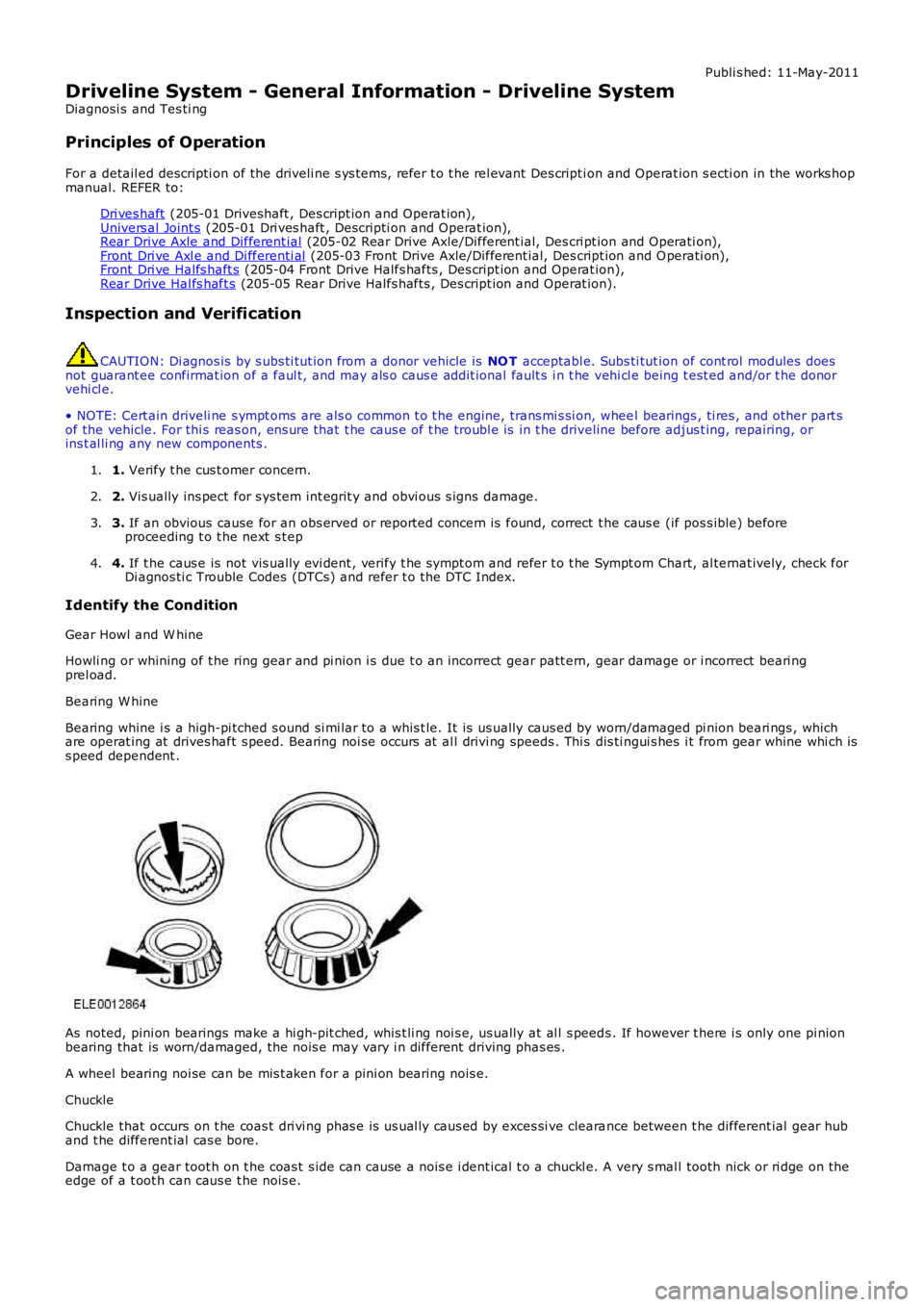
Publi s hed: 11-May-2011
Driveline System - General Information - Driveline System
Diagnosi s and Tes ti ng
Principles of Operation
For a detail ed descripti on of the driveli ne s ys t ems , refer t o t he rel evant Des cript ion and Operat ion s ecti on in the works hopmanual. REFER to:
Dri ves haft (205-01 Driveshaft , Des cript ion and Operat ion),Univers al Joint s (205-01 Dri ves haft , Descripti on and Operat ion),Rear Drive Axle and Different ial (205-02 Rear Drive Axle/Different ial, Des cri pt ion and Operati on),Front Dri ve Axl e and Di fferenti al (205-03 Front Drive Axle/Different ial, Des cript ion and O perati on),Front Dri ve Halfs haft s (205-04 Front Drive Halfs hafts , Des cript ion and Operat ion),Rear Drive Hal fs haft s (205-05 Rear Drive Halfs hafts , Des cript ion and Operat ion).
Inspection and Verification
CAUTION: Di agnos is by s ubs ti tut ion from a donor vehicle is NO T acceptabl e. Subs ti tut ion of cont rol modules doesnot guarant ee confirmat ion of a faul t, and may als o caus e addit ional fault s i n t he vehi cl e being t est ed and/or t he donorvehi cl e.
• NOTE: Cert ain driveli ne s ympt oms are als o common t o t he engine, trans mi s si on, wheel bearings , ti res , and other part sof the vehicle. For thi s reas on, ens ure that t he caus e of t he troubl e is in t he driveline before adjus t ing, repairing, orins t al li ng any new components .
1. Verify t he cus t omer concern.1.
2. Vis ually ins pect for s ys tem int egrit y and obvi ous s igns damage.2.
3. If an obvious cause for an obs erved or report ed concern is found, correct t he caus e (if pos s ible) beforeproceeding t o t he next s t ep3.
4. If t he caus e is not vis ually evi dent , verify t he sympt om and refer t o t he Sympt om Chart, al ternat ively, check forDi agnos ti c Trouble Codes (DTCs) and refer t o t he DTC Index.4.
Identify the Condition
Gear Howl and W hine
Howli ng or whining of t he ring gear and pi nion i s due t o an incorrect gear patt ern, gear damage or i ncorrect beari ngprel oad.
Bearing W hine
Bearing whine i s a high-pi tched s ound si mi lar to a whis t le. It is us ually caus ed by worn/damaged pi nion beari ngs , whichare operat ing at drives haft s peed. Bearing noi se occurs at al l drivi ng speeds . Thi s dis ti ngui s hes i t from gear whine whi ch iss peed dependent .
As noted, pini on bearings make a hi gh-pit ched, whis t li ng noi s e, us ually at al l s peeds . If however t here i s only one pi nionbearing that is worn/damaged, the nois e may vary i n different driving phas es .
A wheel bearing noi se can be mis t aken for a pini on bearing nois e.
Chuckle
Chuckle that occurs on t he coas t dri vi ng phas e is us ual ly caus ed by exces si ve clearance between t he different ial gear huband t he different ial cas e bore.
Damage t o a gear toot h on t he coas t s ide can cause a nois e i dent ical t o a chuckl e. A very s mal l tooth nick or ri dge on theedge of a t oot h can caus e t he nois e.